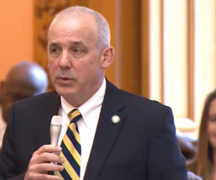Gov. Mike DeWine signed the $74 billion, two-year state budget into law, keeping in place nearly all of its signature policy positions and spending priorities while once again nixing an effort by Republican lawmakers to counter his administration’s methods of handling the deadly COVID-19 pandemic.
The governor also vetoed an attempt by Republican lawmakers to give their party’s legislative leaders sole power to intervene in any potential redistricting lawsuits. The governor wrote in his veto message that this removal came at the request of Attorney General Dave Yost; voter rights groups and Democrats had also urged for the veto of this provision.
As governor, DeWine has the power to issue “line-item vetoes” blocking specific provisions of the budget while signing his approval to the rest.
In total, DeWine issued 14 such line-item vetoes among the more than 2,400-page budget bill. Lawmakers have the power to override any of these vetoes.
Among the vetoes: A provision to vacate public health violations from businesses that were issued over the course of the pandemic. The budget item would have expunged all COVID-19 health violations, ended disciplinary actions in progress and ordered the state to repay any fines collected. Bars and restaurants which had their liquor licenses revoked — in some cases due to flagrant and repeated violations of the public health orders — would’ve had it reinstated.
In his veto statement, DeWine wrote that “Ohio law should not reward businesses and individuals that violated orders and rules adopted to protect Ohioans from the spread of COVID-19 by excusing their actions.”
DeWine vetoed a provision which would have changed the state’s contracting process for a Medicaid managed care system.
DeWine also vetoed provisions related to Medicaid program rates; an exemption of private schools from College Credit Plus laws; and quality controls of community schools.
Unanswered veto requests
While voter rights organizations scored a victory with the veto of the redistricting lawsuits provision, they were unsuccessful in pushing for vetoes of several other budget items condemned as being “anti-democratic.”
This includes the budget eliminating the Citizen’s Education Fund and instituting a prohibition on elections officials collaborating with any “nongovernmental” entity for voter education purposes.
There were other veto wishes that went unfulfilled. Democrats in the Ohio Senate wanted to see the governor remove the elimination of a cap on the number of EdChoice income-based vouchers awarded in Ohio and an income tax credit for private school tuition.
Democrats in the Ohio House of Representatives, meanwhile, joined the Ohio Environmental Council in sharing concerns about budget language they fear would lead to oil and gas drilling in public park lands.
Reproductive rights groups wanted to see DeWine take out provisions threatening the future of two Ohio abortion clinics. Innovation Ohio, a left-leaning policy group, was among the organizations drawing attention to the budget’s “medical practitioner conscience clause” allowing medical professionals to refuse treatment of patients if doing so would violate their personal moral or religious beliefs. Advocates believe this could lead to LGBTQ+ Ohioans being refused treatment.
Policy Matters Ohio, a left-leaning think tank, called on the governor to remove proposed tax cuts that research has shown will largely benefit the state’s wealthiest earners.
However, DeWine championed the 3% income tax cut in a news release announcing the budget signing.
The Ohio Capital Journal will continue to provide coverage on the two-year state budget and the governor’s vetoes.
***
Also from Ohio Capital Journal:
Broadband program salvaged in state budget
City leaders who see internet connectivity as a growing public utility were relieved to find broadband programs and grants kept in the new state budget.
The fate of the Ohio Residential Broadband Expansion Grant Program and municipal broadband programs in the state were in question during budget negotiations.
In the Senate version of the budget, government-owned broadband networks would only have been allowed in “unserved areas,” defined as areas within the municipality that lack access to “tier one” or “tier two” broadband services. Tier one service has speeds of at least 10 but less than 25 megabits per second (Mbps) downstream and at least one but less than three megabits per second upstream. Tier two service is defined by the state as at least 25 Mbps downstream and at least three Mbps upstream.
The speeds defined as tier two service are the FCC’s definition of minimum speeds for broadband. READ MORE





